You're reading the documentation of the v1.0. For the latest released version, please have a look at v1.1.
Unitary Components
Overview
Name |
Class Name |
|
|
Unitary Matrix |
|---|---|---|---|---|
|
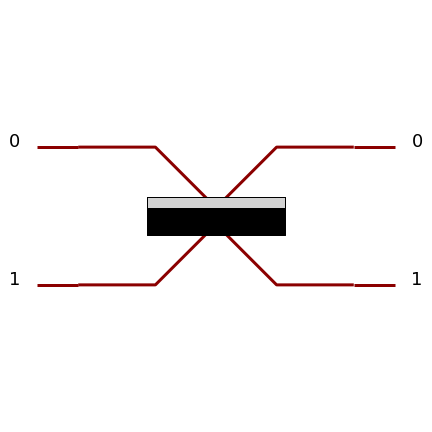
|

|
Depends on the convention, see Beam Splitter |
|
|

|
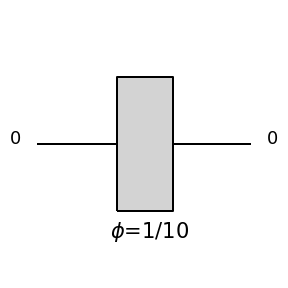
|
\(\left[\begin{matrix}e^{i \phi}\end{matrix}\right]\) |
|
|
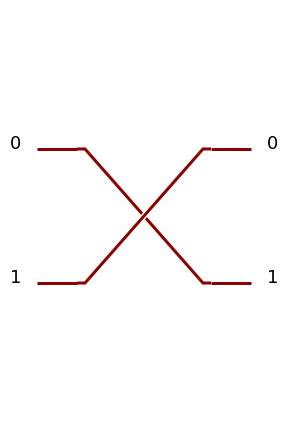
|
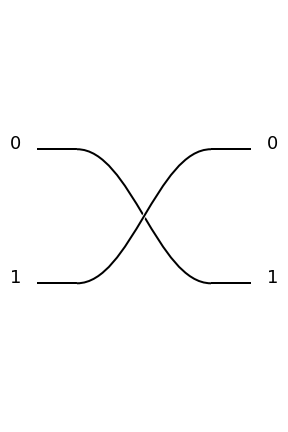
|
Example of a two mode permutation: \(\left[\begin{matrix}0 & 1\\1 & 0\end{matrix}\right]\) |
|
|

|
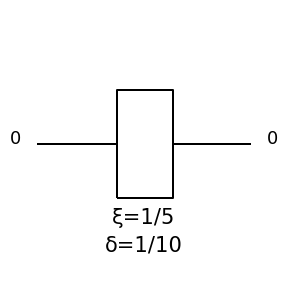
|
\(\left[\begin{matrix}i \sin{\left(\delta \right)} \cos{\left(2 \xi \right)} + \cos{\left(\delta \right)} & i \sin{\left(\delta \right)} \sin{\left(2 \xi \right)}\\i \sin{\left(\delta \right)} \sin{\left(2 \xi \right)} & - i \sin{\left(\delta \right)} \cos{\left(2 \xi \right)} + \cos{\left(\delta \right)}\end{matrix}\right]\) |
|
|

|
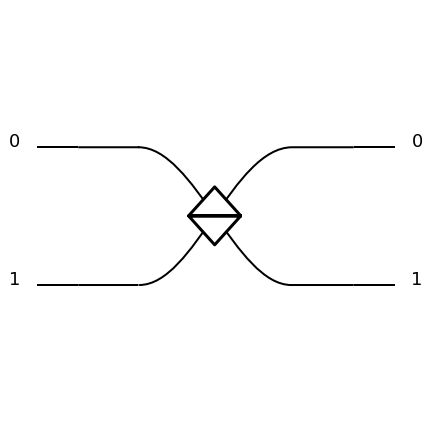
|
\(\left[\begin{matrix}0 & 0 & 1 & 0\\0 & 1 & 0 & 0\\1 & 0 & 0 & 0\\0 & 0 & 0 & 1\end{matrix}\right]\) |
|
|

|
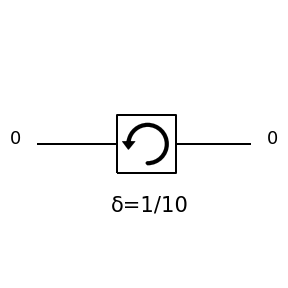
|
\(\left[\begin{matrix}\cos{\left(\delta \right)} & \sin{\left(\delta \right)}\\- \sin{\left(\delta \right)} & \cos{\left(\delta \right)}\end{matrix}\right]\) |
Beam Splitter
Beam Splitter conventions
- enum perceval.components.unitary_components.BSConvention(value)
Beam splitter conventions
- Member Type:
int
Valid values are as follows:
- Rx = <BSConvention.Rx: 0>
- Ry = <BSConvention.Ry: 1>
- H = <BSConvention.H: 2>
Three specialised conventions are defined, with a single \(\theta\) parameter, as follow:
Convention |
Unitary matrix |
Default value (\(\theta=\pi/2\)) |
Comment |
|---|---|---|---|
|
\(\left[\begin{matrix}\cos{(\theta/2)} & i \sin{(\theta/2)}\\i \sin{(\theta/2)} & \cos{(\theta/2)}\end{matrix}\right]\) |
\(\left[\begin{matrix}1 & i\\i & 1\end{matrix}\right]\) |
Symmetrical, default convention |
|
\(\left[\begin{matrix}\cos{(\theta/2)} & -\sin{(\theta/2)}\\ \sin{(\theta/2)} & \cos{(\theta/2)}\end{matrix}\right]\) |
\(\left[\begin{matrix}1 & -1\\1 & 1\end{matrix}\right]\) |
Real, non symmetrical |
|
\(\left[\begin{matrix}\cos{(\theta/2)} & \sin{(\theta/2)}\\ \sin{(\theta/2)} & -\cos{(\theta/2)}\end{matrix}\right]\) |
\(\left[\begin{matrix}1 & 1\\1 & -1\end{matrix}\right]\) |
Hadamard gate, |
Each convention also accepts up to four additional phases, mimicking a phase shifter on each mode connected to the beam
splitter. For instance, with the Rx convention, the unitary matrix is defined by:
\(\left[\begin{matrix}e^{i(\phi_{tl}+\phi_{tr})} \cos{\left(\theta/2 \right)} & i e^{i (\phi_{tr}+\phi_{bl})} \sin{\left(\theta/2 \right)}\\i e^{i \left(\phi_{tl} + \phi_{br}\right)} \sin{\left(\theta/2 \right)} & e^{i (\phi_{br}+\phi_{bl})} \cos{\left(\theta/2 \right)}\end{matrix}\right]\)
It is thus parametrized by \(\theta\), \(\phi_{tl}\), \(\phi_{bl}\), \(\phi_{tr}\) and \(\phi_{br}\) angles, making this beam splitter equivalent to:
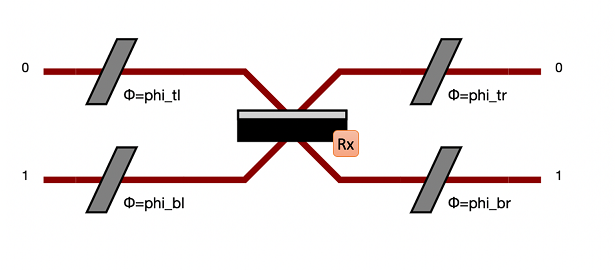
Beam Splitter reflectivity
\(\theta\) relates to the reflectivity and \(\phi\) angles correspond to relative phases between modes. Beam splitters exist as bulk, fibered and on-chip components.
The relationship between the reflectivity \(R\) and \(\theta\) is: \(cos {\left( \theta/2 \right)} = \sqrt{R}\).
To create a beam splitter object with a given reflectivity value:
>>> from perceval.components import BS
>>> R = 0.45
>>> beam_splitter = BS(BS.r_to_theta(R))
Beam Splitter code reference
- class perceval.components.unitary_components.BS(theta=pi / 2, phi_tl=0, phi_bl=0, phi_tr=0, phi_br=0, convention=BSConvention.Rx)
Beam Splitter
Beam splitters couple two spatial modes together, acting on \(\ket{1,0}\) and \(\ket{0,1}\).
- Parameters:
- static H(theta=pi / 2, phi_tl=0, phi_bl=0, phi_tr=0, phi_br=0)
Convenient named constructor for a Beam Splitter following Hadamard convention. Its parameters are the same as the main constructor.
- static Rx(theta=pi / 2, phi_tl=0, phi_bl=0, phi_tr=0, phi_br=0)
Convenient named constructor for a Beam Splitter following Rotation X convention. Its parameters are the same as the main constructor.
- static Ry(theta=pi / 2, phi_tl=0, phi_bl=0, phi_tr=0, phi_br=0)
Convenient named constructor for a Beam Splitter following Rotation Y convention. Its parameters are the same as the main constructor.
- property U
get the symbolic unitary matrix
- assign(assign=None)
Assign values to parameters referenced in assign
- Parameters:
assign (
Optional[dict[str,float|int]]) – A dictionary mapping parameter_name -> value. Set the value to the parameter whose name is parameter_name for each key of the dictionary.- Raises:
KeyError – If parameter_name is not an existing variable parameter name of the circuit.
- compute_unitary(assign=None, use_symbolic=False, use_polarization=None)
Compute the unitary matrix corresponding to the current circuit
- Parameters:
use_polarization (
Optional[bool]) – ask for polarized circuit to double size unitary matrixassign (
Optional[dict]) – optional mapping between parameter names and their corresponding valuesuse_symbolic (
bool) – if the matrix should use symbolic calculation
- Return type:
- Returns:
the unitary matrix, will be a
MatrixSif symbolic, or a ~`MatrixN` if not.
- property convention
Beam splitter convention
- property defined: bool
check if all parameters of the circuit are fully defined
- definition()
Gives mathematical definition of the circuit
Only defined for elementary circuits
- depths()
- Returns:
the depth of the circuit for each mode
- describe()
Describe the component as the Python code that generates it.
- Return type:
str- Returns:
code generating the component
- get_parameters(all_params=False, expressions=False)
Return the parameters of the component
- Parameters:
all_params (
bool) – if False, only returns the variable parametersexpressions – if True, returns Expressions and parameters embedded in circuit components. If False, returns the raw parameters that make up the expressions only. Default False.
- Return type:
list[Parameter]- Returns:
the list of parameters
- property name
Returns component name
- ncomponents()
- Returns:
number of actual components in the circuit
- param(param_name)
Extract a Parameter object from its name :type param_name:
str:param param_name: The name of the parameter :rtype:Parameter:return: A Parameter object
- property params: Iterable[str]
- Returns:
a list of all variable parameter names in the component
- static r_to_theta(r)
Compute theta given a reflectivity value. Supports symbolic computing.
- Parameters:
r (
float|Parameter) – reflectivity value (can be variable)- Return type:
float|Expression- Returns:
theta value or symbolic expression
- property reflectivity
Beam Splitter reflectivity
- Returns:
reflectivity of the current Beam Splitter
- property requires_polarization
Does the circuit require polarization?
- Returns:
is True if the circuit has a polarization component
- static theta_to_r(theta)
Compute reflectivity given a theta value. Supports symbolic computing.
- Parameters:
theta (
float|Parameter) – theta angle (can be variable)- Return type:
float|Expression- Returns:
reflectivity value or symbolic expression
- property vars: dict[str, perceval.utils.parameter.Parameter]
- Returns:
A dictionary mapping parameter names to parameters for all variable parameters of the circuit
Phase Shifter
- class perceval.components.unitary_components.PS(phi, max_error=0)
Phase shifter
A phase shifter adds a phase \(\phi\) on a spatial mode, which corresponds to a Z rotation in the Bloch sphere.
- Parameters:
- definition()
Gives mathematical definition of the circuit
Only defined for elementary circuits
- Return type:
- describe()
Describe the component as the Python code that generates it.
- Returns:
code generating the component
Permutation
A permutation swaps multiple consecutive spatial modes.
To create a permutation PERM sending \(\ket{0,1}\) to \(\ket{1,0}\) and vice-versa:
>>> from perceval.components import PERM
>>> permutation = PERM([1, 0])
More generally, one can define a permutation on an arbitrary number of modes. The permutation is described by a list of integers from 0 to \(l-1\), where \(l\) is the length of the list. The \(k^{th}\) spatial input mode is sent to the spatial output mode corresponding to the \(k\) th value in the list.
For instance the following defines a 4-mode permutation. It matches the first input path (index 0) with the third output path (value 2), the second input path with the fourth output path, the third input path, with the first output path, and the fourth input path with the second output path.
>>> import perceval as pcvl
>>> import perceval.components.unitary_components as comp
>>> c = comp.PERM([2, 3, 1, 0])
>>> pcvl.pdisplay(c)
>>> pcvl.pdisplay(c.compute_unitary(), output_format=pcvl.Format.LATEX)
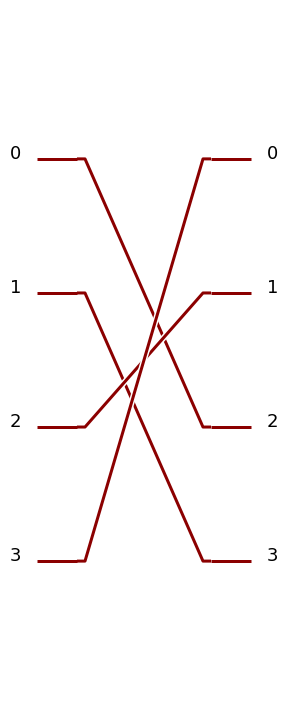
|
\[\begin{split}\left[\begin{matrix}0 & 0 & 0 & 1\\0 & 0 & 1 & 0\\1 & 0 & 0 & 0\\0 & 1 & 0 & 0\end{matrix}\right]\end{split}\]
|
- class perceval.components.unitary_components.PERM(perm)
Permutation
A swap between any number of consecutive spatial modes.
- Parameters:
perm (
list[int]) – Vector of mode index defining the permutation.
>>> permutation = PERM([2, 3, 1, 0]) # respectively swaps mode 0 to 2, 1 to 3, 2 to 1 and 3 to 0.
- apply(r, sv)
Apply the permutation to a state
- Parameters:
r (
tuple[int,...]) – Range of consecutive modes where the permutation occurs- Sv:
State on which the permutation is applied
- break_in_2_mode_perms()
Breaks any n-mode permutation into an equivalent circuit made of only 2-mode permutations.
- Returns:
An equivalent Circuit made of only 2-mode permutations
- definition()
Gives mathematical definition of the circuit
Only defined for elementary circuits
- describe()
Describe the component as the Python code that generates it.
- Returns:
code generating the component
- property perm_vector
Return the permutation vector
Unitary
- class perceval.components.unitary_components.Unitary(U, name=None, use_polarization=False)
Generic component defined by a unitary matrix
- Parameters:
U (
Matrix) – numeric matrix. Does not support symbolic computation.name (
Optional[str]) – Custom name for the component it represents (default is “Unitary”).use_polarization (
bool) – True if the unitary represents a polarized component.
- describe()
Describe the component as the Python code that generates it.
- Returns:
code generating the component
Wave Plate
- class perceval.components.unitary_components.WP(delta, xsi)
A wave plate acts on the polarisation modes of a single spatial mode. This component acts on polarised photons. See also: Polarisation
- Parameters:
delta (
float|Parameter) – parameter proportional to the thickness of the waveplatexsi (
float|Parameter) – angle of the waveplate’s optical axis in the \(\left\{\ket{H}, \ket{V}\right\}\) plane. Especially important is the case that \(\delta=\pi/2\), known as a half-wave plate, which rotates linear polarisations in the \(\left\{\ket{H}, \ket{V}\right\}\) plane.
- describe()
Describe the component as the Python code that generates it.
- Returns:
code generating the component
Polarisation Rotator
- class perceval.components.unitary_components.PR(delta)
A polarisation rotator is an optical device that rotates the polarization axis of a linearly polarized light beam by an angle of choice. Such devices can be based on the Faraday effect, on bi-refringence, or on total internal reflection. Rotators of linearly polarized light have found widespread applications in modern optics since laser beams tend to be linearly polarized. It is often necessary to rotate the original polarization to its orthogonal alternative. This component acts on polarized photons. See also: Polarization
See https://en.wikipedia.org/wiki/Polarization_rotator for more details.
- Parameters:
delta (
float|Parameter) – Rotation angle
- describe()
Describe the component as the Python code that generates it.
- Returns:
code generating the component
Polarising Beam Splitter
- class perceval.components.unitary_components.PBS
A polarising beam splitter converts a superposition of polarisation modes in a single spatial mode to the corresponding equal-polarisation superposition of two spatial modes, and vice versa, and so in this sense allows us to translate between polarisation and spatial modes. The unitary matrix associated to a polarising beam splitter acting on the tensor product of the spatial mode and the polarisation mode is:
\(\left[\begin{matrix}0 & 0 & 1 & 0\\0 & 1 & 0 & 0\\1 & 0 & 0 & 0\\0 & 0 & 0 & 1\end{matrix}\right]\)
This component acts on polarized photons. See also: Polarization
- describe()
Describe the component as the Python code that generates it.
- Returns:
code generating the component
Barrier
- class perceval.components.unitary_components.Barrier(m, visible=True)
A barrier is a visual component which has no effect on photons (it behaves as an identity unitary). It may be used to separate or align multiple components in a given Circuit.
- Parameters:
m (
int) – Number of consecutive modes it coversvisible (
bool) – The barrier is rendered if True, and is invisible otherwise
- definition()
Gives mathematical definition of the circuit
Only defined for elementary circuits
- describe()
Describe the component as the Python code that generates it.
- Returns:
code generating the component